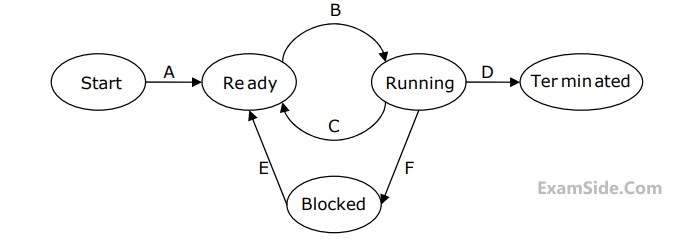
Now consider the following statements:
$$1.\,\,\,$$ If a process makes a transition $$D,$$ it would result in another process making transition $$A$$ immediately.
$$2.\,\,\,$$ $$A$$ process $${P_2}$$ in blocked state can make transition $$E$$ while another process $${P_1}$$ is in running state.
$$3.\,\,\,$$ The $$OS$$ uses preemptive scheduling.
$$4.\,\,\,$$ The $$OS$$ uses non-preemptive scheduling.
Which of the above statements are TRUE?
void enter_CS(X) {
while test-and-set(X) ;
}
void leave_CS(X) {
X=0;
}I. The above solution to CS problem is deadlock-free
II. The solution is starvation free.
III. The processes enter CS in FIFO order.
IV More than one process can enter CS at the same time.
Which of the above statements is TRUE?
$${\rm I}.\,\,\,\,\,\,\,\,\,\,\,$$ Content coupling
$${\rm II}.\,\,\,\,\,\,\,\,\,$$ Common coupling
$${\rm III}.\,\,\,\,\,\,\,$$ Control coupling
$${\rm IV}.\,\,\,\,\,\,\,$$ Stamp coupling
$${\rm V}.\,\,\,\,\,\,\,\,\,$$ Data coupling
Coupling between modules can be ranked in the order of strongest (least desirable) to weakest (most desirable) as follows.
$${\rm I}.\,\,\,\,\,\,$$ The cyclomatic complexity of a module is equal to the maximum number of
$$\,\,\,\,\,\,\,\,\,\,\,$$linearly independent circuits in the graph.
$${\rm II}.\,\,\,$$ The cyclomatic complexity of a module is the number of decisions in the
$$\,\,\,\,\,\,\,\,\,\,$$module plus one, where a decision is effectively any conditional statement in
$$\,\,\,\,\,\,\,\,\,\,$$the module.
$${\rm III}\,$$ The cyclomatic complexity can also be used as a number of linearly
$$\,\,\,\,\,\,\,\,\,\,$$independent paths that should be tested during path coverage testing.